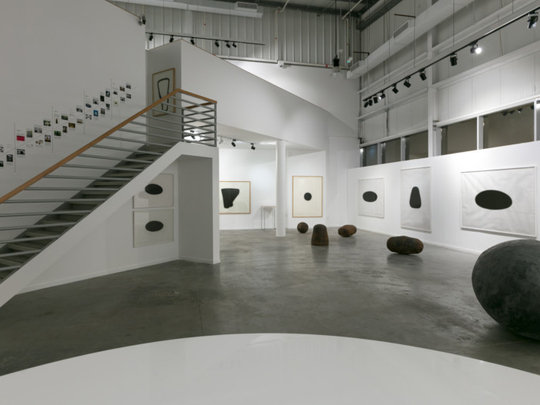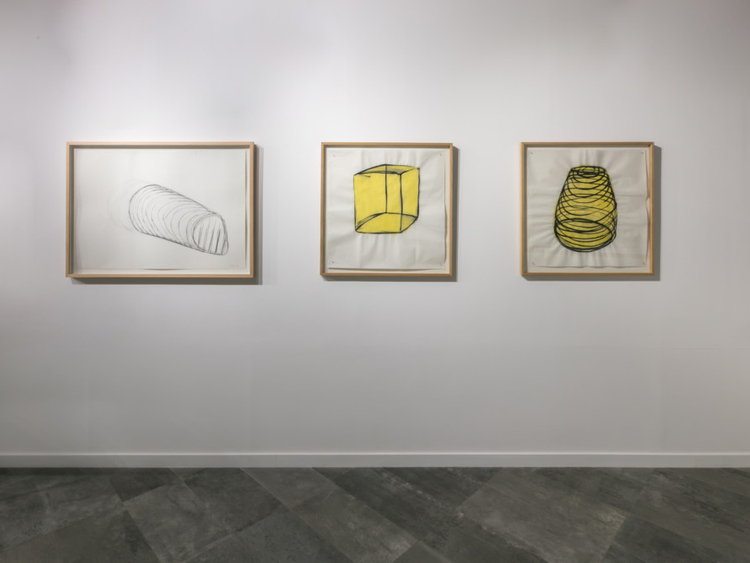
The Jean-Paul Najar Foundation (JPNF) is presenting Jene Highstein: Space and Place, a solo exhibition of the American artist’s seminal sculptures and works on paper created between the 1970s and 1990s. Highstein, who died in 2013, was a key figure of post-minimalist sculptural abstraction. He was interested in exploring the relationship of sculpture to its surroundings and its impact on the viewer’s perception of space. Through his simple but strong sculptures he wanted to create a dialogue between raw materials and nature, while emphasising the physical presence of the sculpture and the surrounding space.
The artist worked with bronze, concrete, steel and wood to create dense, heavy sculptures with primal organic forms, and often exhibited his works in parks and forests, where they challenged the space around them, while also being subtly altered by their surroundings and elements of nature. The show presents Highstein’s drawings alongside his sculptures tracing the evolution of his abstract style and his experiments with form and space.
As a collector and art patron, Jean-Paul Najar appreciated Highstein’s work from the beginning of his career and supported the artist by commissioning works and funding his projects. While most of the works in the show are from the JPNF collection, it also includes works loaned by the artist’s estate. The show also includes photographs, films, letters, sketchbooks, catalogues and articles published about the artist taken from the JPNF archives that offer insights into the artist’s creative processes and the key events and exhibitions of his career.
The drawings accompanying Highstein’s forged steel and concrete sculptures in the show are done with bone black pigment and Chinese ink. The artist liked to use bone black pigment because it is one of the earliest forms of black tinting material known to man and fulfilled his desire to return to primordial mediums, forms and concepts. He also liked it because the intensity of the pigment’s blackness gave the simple forms in his drawings the same strong presence and sense of compact mass and weight as his sculptures. Viewing the sculptures alongside drawings of similar shapes helps viewers to understand how the dark two-dimensional ellipsoids floating in space in the drawings transformed into solid three-dimensional spheres, mounds and totems.
Highstein created his drawings exactly like his sculptures. He first drew a frame like a steel armature with graphite and then painted it with bone black pigment in an act similar to covering of the frame with chicken wire and then layers of cement. The process is visible in some of the drawings where he has left part of the graphite armature uncovered. Often the drawings were made after the sculpture and each was an independent work of art.
An important work in the show is Multiple Distortions which Highstein produced in Najar’s home in Paris in 1975. The large ovoid steel armature covered in cement is 6.5 metres in height and eight metres wide. It has weight, gravity and a strong condensed presence, which is mirrored in an accompanying drawing. The mysterious curves, cracks and discolourations in the sculpture invite viewers to move around it and become aware of the space they inhabit and the presence of the abstracted form.
Najar got an architect to make structural modifications to his home and to reinforce the floor to make it possible for the sculpture to be produced inside his living room and displayed there. Every stage of the creation of this work from conception to completion and display is documented in letters, photographs and a film included in the show. Besides offering an insight into the artist’s creative process, the images also indicate the responsibility a collector takes on when acquiring or commissioning a large work of art.
Other works in the show commissioned by Najar include a group of forged steel sculptures with titles such as Small Lump of Clay and Bullet alluding to their forms. Highstein made these in a foundry in Rive-de-Gier, France and they were later exhibited in the St Etienne Museum in Paris. The sculptures, created by compressing metal under extreme pressure followed by polishing with a chainsaw, weigh between 600 to 1,000kg, challenging our perception of mass. The bumps, dents, cracks and rust on their surfaces left behind by the mechanical process, natural forces and the passage of time add to their biomorphic feel.
In the accompanying drawings the same curved, dense, black shapes seem to float weightlessly in the stark white space around them. A film of the production process and photographs of the sculptures displayed in parks and forests help viewers to understand why Highstein’s works were described by art writers of the time as ‘not abstracted from nature, but re-natured abstractions’.
In a set of works loaned by the artist’s estate for this show, the ellipsoid shapes are transformed into more elongated and swollen organic forms. The artist gave these works mythical titles such as Venus of Alenquer, Little Egypt and One Foot infusing the abstracted forms with religious, mythological and other associations.
Besides his strong, solid biomorphic forms, Highstein also explored lines as spatial devices. In a series of charcoal and graphite drawings he has used a simple line that splits and expands on a large white canvas to alter and activate the space around it.
In the mid-2000s Highstein became interested in painting with Chinese ink and watercolours. He liked Chinese Calligraphy and the Chinese style of landscape art where rather than painting on site artists absorb the feeling and energy of the landscape and later paint from memory. In a set of paintings on rice paper from this period he has captured the feeling and power of vortices, moving away from dense, compact shapes to more fluid spirals.
He also moved from using industrial materials for his sculptures to working with a natural material such as wood. The show features one of his earliest wood sculptures hand carved from walnut wood, where he has played skilfully with the grains, striations and discolourations in the material.
In keeping with its mission to engage the community with contemporary art, the JPNF has organised a comprehensive educational public programme to accompany the show which includes talks, film screenings of Highstein’s theatre set designs and performances, guided tours for university students, and drawing and sculpture workshops for children and adults.
Space and Place will run at the Jean-Paul Najar Foundation in Alserkal Avenue, Al Quoz, until June 30.













